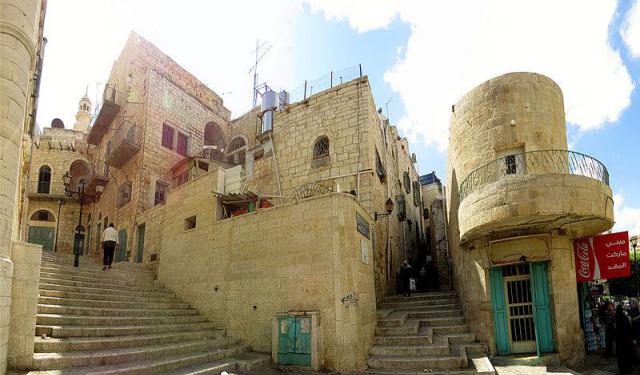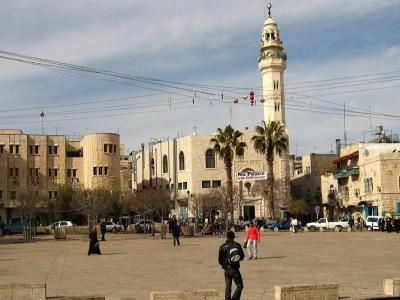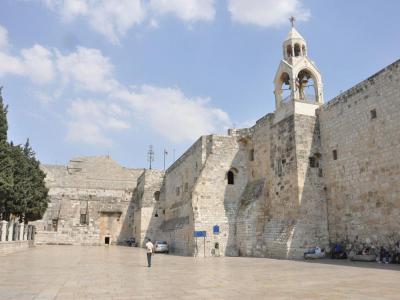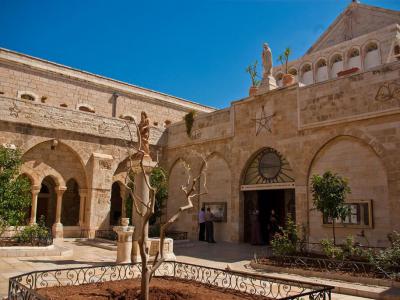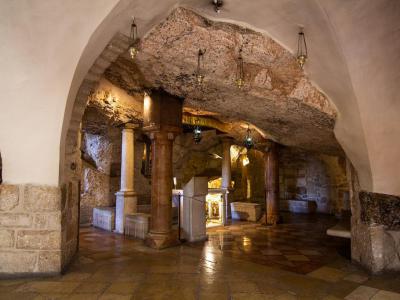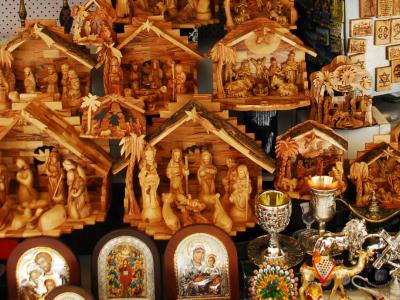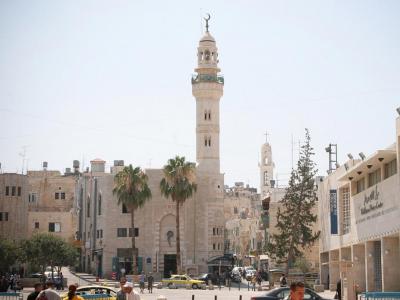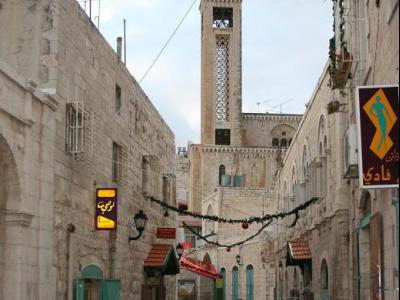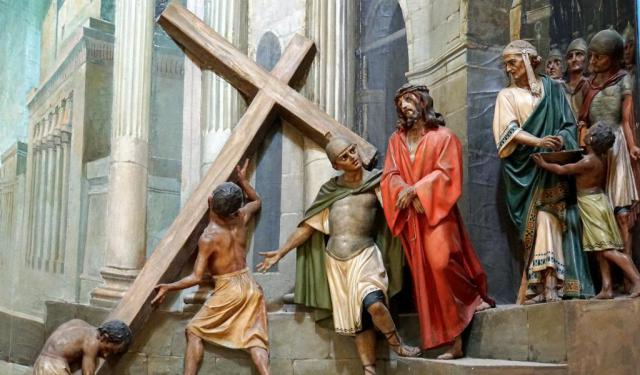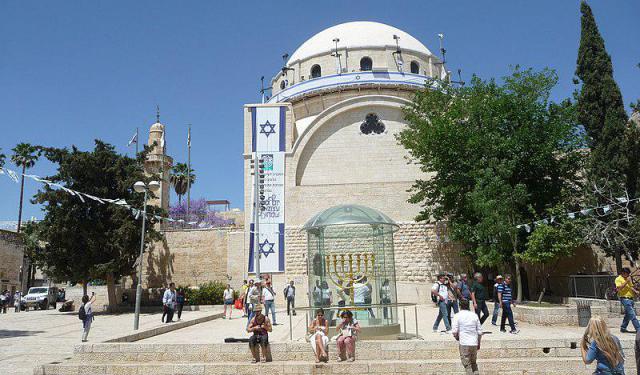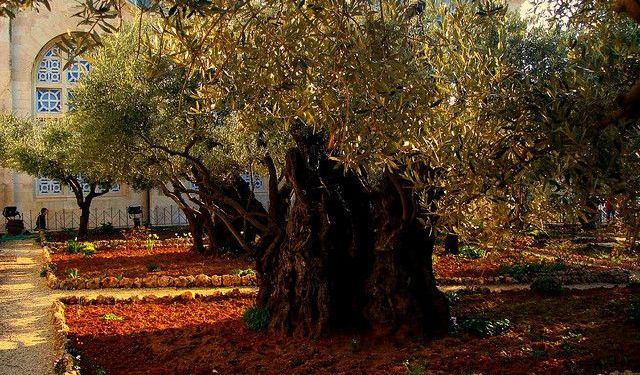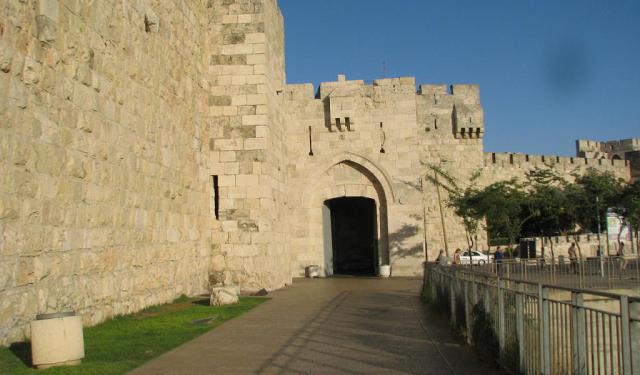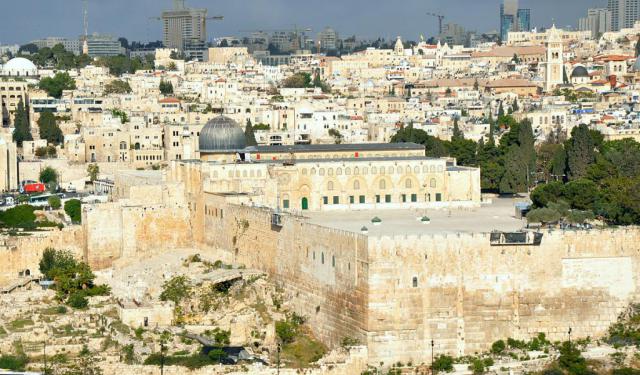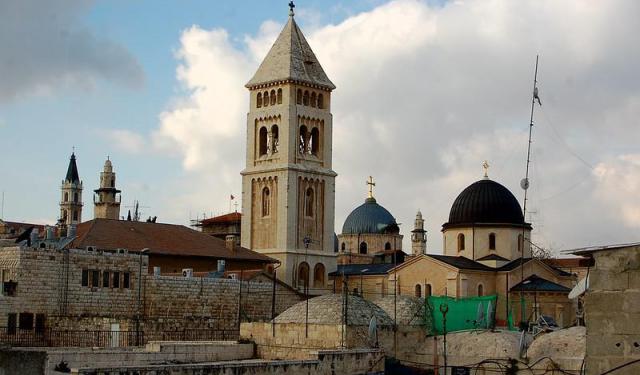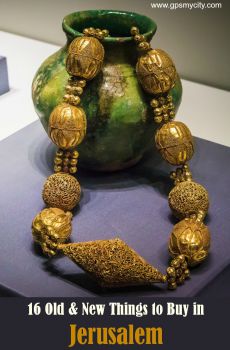Bethlehem Walking Tour (Self Guided), Jerusalem
Perched on a hill at the edge of the Judaean Desert, Bethlehem has been known to the world, for more than two millennia, as the birthplace of Jesus Christ. The “star of Bethlehem” as well as Christmas carols and hymns are firmly associated with this ancient city in the West Bank, Palestine, and thus, for some visitors, the bustle of a modern city may come as a surprise.
Undoubtedly, the main tourist attraction of Bethlehem remains the Church of the Nativity on Manger Square, constructed by Emperor Constantine in the 4th century AD. For anyone – religious or otherwise – who has ever celebrated Christmas, it’s a definite must-visit site with lots to feast the eyes on, including an unbelievable amount of mosaics and ancient artefacts. Make sure to take plenty of photos while there!
There is more to Bethlehem than just that standalone landmark, however. Only five minutes’ walk of Manger Square you’ll find another major Christian landmark – the Milk Grotto, where it is said the Holy Family took refuge during the Slaughter of the Innocents, before their eventual flight into Egypt, and Mary let a drop of her milk fall to the ground while nursing Jesus, so turning the rock from red to chalky white. The present building, a cool and serene escape from the summer heat outside, was put up by the Franciscans in the 1870s on the site of a 4thcentury church. On your way to it, you’ll find numerous souvenir shops selling fine olivewood and mother-of-pearl carvings that local craftsmen have produced for centuries.
Among other highlights are the Church of Saint Catherine, from where the Christmas Eve Midnight Mass is televised and beamed worldwide; the 15th-century Mosque of Omar with its distinctive square minaret, and fascinating traditional architecture dating to the Ottoman period in Palestine (1515–1917), particularly on Star Street.
Join us on this self-guided walking tour for an unforgettable experience in Bethlehem!
Undoubtedly, the main tourist attraction of Bethlehem remains the Church of the Nativity on Manger Square, constructed by Emperor Constantine in the 4th century AD. For anyone – religious or otherwise – who has ever celebrated Christmas, it’s a definite must-visit site with lots to feast the eyes on, including an unbelievable amount of mosaics and ancient artefacts. Make sure to take plenty of photos while there!
There is more to Bethlehem than just that standalone landmark, however. Only five minutes’ walk of Manger Square you’ll find another major Christian landmark – the Milk Grotto, where it is said the Holy Family took refuge during the Slaughter of the Innocents, before their eventual flight into Egypt, and Mary let a drop of her milk fall to the ground while nursing Jesus, so turning the rock from red to chalky white. The present building, a cool and serene escape from the summer heat outside, was put up by the Franciscans in the 1870s on the site of a 4thcentury church. On your way to it, you’ll find numerous souvenir shops selling fine olivewood and mother-of-pearl carvings that local craftsmen have produced for centuries.
Among other highlights are the Church of Saint Catherine, from where the Christmas Eve Midnight Mass is televised and beamed worldwide; the 15th-century Mosque of Omar with its distinctive square minaret, and fascinating traditional architecture dating to the Ottoman period in Palestine (1515–1917), particularly on Star Street.
Join us on this self-guided walking tour for an unforgettable experience in Bethlehem!
How it works: Download the app "GPSmyCity: Walks in 1K+ Cities" from Apple App Store or Google Play Store to your mobile phone or tablet. The app turns your mobile device into a personal tour guide and its built-in GPS navigation functions guide you from one tour stop to next. The app works offline, so no data plan is needed when traveling abroad.
Bethlehem Walking Tour Map
Guide Name: Bethlehem Walking Tour
Guide Location: Israel » Jerusalem (See other walking tours in Jerusalem)
Guide Type: Self-guided Walking Tour (Sightseeing)
# of Attractions: 8
Tour Duration: 1 Hour(s)
Travel Distance: 1.5 Km or 0.9 Miles
Author: vickyc
Sight(s) Featured in This Guide:
Guide Location: Israel » Jerusalem (See other walking tours in Jerusalem)
Guide Type: Self-guided Walking Tour (Sightseeing)
# of Attractions: 8
Tour Duration: 1 Hour(s)
Travel Distance: 1.5 Km or 0.9 Miles
Author: vickyc
Sight(s) Featured in This Guide:
- Manger Square (Bethlehem)
- Church of the Nativity (Bethlehem)
- Church of St. Catherine (Bethlehem)
- Wij Al Amar (Bethlehem)
- Milk Grotto (Bethlehem)
- Milk Grotto Street Shops (Bethlehem)
- Mosque of Omar (Bethlehem)
- Star Street (Bethlehem)
1) Manger Square (Bethlehem)
Nestled in the heart of the Old City, Manger Square serves as the perfect launching pad for your Bethlehem adventure. Its name pays homage to the legendary manger where Jesus is said to have been born, a revered site enshrined within the historic Church of the Nativity on the square's eastern flank since the fourth century. On the opposite side stands the graceful Church of Saint Catherine, complemented by the distinctive Mosque of Omar, a symbol of diversity in this ancient city, and the Palestinian Peace Center.
Wandering through the streets leading to the square, such as Star Street and Nativity Street, one can't help but feel the connection to Christian faith and tradition. In an effort to ease traffic congestion, the square underwent a revitalization in 1998–99, transforming into a pedestrian-friendly oasis. It now serves as a vibrant gathering spot for locals and the multitude of pilgrims who flock here.
Shaded by rows of majestic celtis australis trees, Manger Square beckons visitors to linger a while, offering respite on benches crafted from the famed Naqab marble. Amidst this tranquil setting, modernity meets tradition with the bustling Bethlehem Peace Center, the stately Municipality building, and an inviting arcade housing quaint shops and eateries. Keep an eye out for lively festivals and concerts that occasionally grace the square, adding an extra layer of excitement.
Wandering through the streets leading to the square, such as Star Street and Nativity Street, one can't help but feel the connection to Christian faith and tradition. In an effort to ease traffic congestion, the square underwent a revitalization in 1998–99, transforming into a pedestrian-friendly oasis. It now serves as a vibrant gathering spot for locals and the multitude of pilgrims who flock here.
Shaded by rows of majestic celtis australis trees, Manger Square beckons visitors to linger a while, offering respite on benches crafted from the famed Naqab marble. Amidst this tranquil setting, modernity meets tradition with the bustling Bethlehem Peace Center, the stately Municipality building, and an inviting arcade housing quaint shops and eateries. Keep an eye out for lively festivals and concerts that occasionally grace the square, adding an extra layer of excitement.
2) Church of the Nativity (Bethlehem) (must see)
Standing tall and formidable, the Church of the Nativity commands attention from its perch in Manger Square, Bethlehem's historic heart. Its claim to fame as the birthplace of Jesus Christ traces back to a tumultuous past, marked by Roman paganism, Byzantine grandeur, and Crusader expansion. Legend has it that Emperor Hadrian's shrine to Adonis once overshadowed the sacred Grotto of the Nativity, until Saint Helena, Constantine's mother, unearthed the hallowed site in the 4th century. This discovery led to the construction of the original church in 339 AD, a structure that has since undergone Byzantine reconstruction and Crusader-era embellishments.
Inside, a delicate balance prevails among the Greek Orthodox, Armenian Orthodox, and Roman Catholic factions, each asserting rights over the revered sanctuary. Yet, this harmony belies a turbulent history marked by violent disputes, including the infamous Crimean War. More recently, in 2002, amidst a siege by Israeli forces, the church offered refuge to over 200 Palestinians.
The humble entrance, known as the Door of Humility, bears witness to centuries of architectural evolution, its lowered stature a relic of past military strategies. The interior reveals a sanctuary adorned with golden columns and ancient mosaics, relics of Constantine's original vision. Beneath the oak-clad ceiling lies the Grotto of the Nativity, a sacred enclave where a silver star marks the exact spot of Christ's birth. Amidst the flicker of lamps, a sense of reverence permeates the air, a reminder of the enduring significance of this sacred site.
Descending into the Chapel of the Manger unveils the scene of Christ's birth, immortalized in marble and paintings. Here, amidst echoes of ancient prophecy, visitors pay homage to the humble beginnings of Christianity's central figure.
Inside, a delicate balance prevails among the Greek Orthodox, Armenian Orthodox, and Roman Catholic factions, each asserting rights over the revered sanctuary. Yet, this harmony belies a turbulent history marked by violent disputes, including the infamous Crimean War. More recently, in 2002, amidst a siege by Israeli forces, the church offered refuge to over 200 Palestinians.
The humble entrance, known as the Door of Humility, bears witness to centuries of architectural evolution, its lowered stature a relic of past military strategies. The interior reveals a sanctuary adorned with golden columns and ancient mosaics, relics of Constantine's original vision. Beneath the oak-clad ceiling lies the Grotto of the Nativity, a sacred enclave where a silver star marks the exact spot of Christ's birth. Amidst the flicker of lamps, a sense of reverence permeates the air, a reminder of the enduring significance of this sacred site.
Descending into the Chapel of the Manger unveils the scene of Christ's birth, immortalized in marble and paintings. Here, amidst echoes of ancient prophecy, visitors pay homage to the humble beginnings of Christianity's central figure.
3) Church of St. Catherine (Bethlehem)
Joined to the Church of the Nativity, the Roman Catholic Church of Saint Catherine adds another layer to Bethlehem's sacred tapestry. Constructed in 1881, it incorporates remnants of Crusader architecture unearthed during its creation. Here, amidst the solemnity of its walls, the faithful gather to honor Saint Catherine of Alexandria, to whom Christ is said to have appeared.
A highlight of the church's calendar is the Christmas Eve Midnight Mass, broadcast to viewers around the globe. Equally worth watching is the daily procession of Franciscan Fathers, a timeless ritual that draws observers at noon (or 1 PM during daylight saving).
Descending medieval stairs from the church, visitors are transported into a labyrinth of caves and tombs, intricately linked to the Grotto of the Nativity. While access between the two is restricted, the subterranean complex offers a glimpse into biblical history and lore. At its heart lies the main altar dedicated to Saint Joseph, guardian of the infant Jesus. Here, amidst flickering candlelight, pilgrims pay homage to the saint who heeded the angel's warning, leading the Holy Family to safety in Egypt.
Nearby, the Chapel of the Innocents stands as a solemn tribute to the lives lost in Herod's ruthless pursuit of power, while further within, the tomb and statues of Saint Jerome, a revered Dalmatian priest, serve as testament to his monumental Old Testament translation.
A highlight of the church's calendar is the Christmas Eve Midnight Mass, broadcast to viewers around the globe. Equally worth watching is the daily procession of Franciscan Fathers, a timeless ritual that draws observers at noon (or 1 PM during daylight saving).
Descending medieval stairs from the church, visitors are transported into a labyrinth of caves and tombs, intricately linked to the Grotto of the Nativity. While access between the two is restricted, the subterranean complex offers a glimpse into biblical history and lore. At its heart lies the main altar dedicated to Saint Joseph, guardian of the infant Jesus. Here, amidst flickering candlelight, pilgrims pay homage to the saint who heeded the angel's warning, leading the Holy Family to safety in Egypt.
Nearby, the Chapel of the Innocents stands as a solemn tribute to the lives lost in Herod's ruthless pursuit of power, while further within, the tomb and statues of Saint Jerome, a revered Dalmatian priest, serve as testament to his monumental Old Testament translation.
4) Wij Al Amar (Bethlehem)
Wij Al-Amar presents an exquisite fusion of culinary traditions from Europe, the Middle East, and Latin America. Its elegant interior, blending wood, metal, and stone detailing, sets the stage for memorable lunches and dinners. And for those seeking refreshment, the bar offers a selection of the finest cocktails, available from noon until midnight.
The open show kitchen, a unique feature in the Bethlehem area, serves as the culinary heart of the restaurant. A premium is placed on cleanliness, simplicity and quality, using the best seasonal ingredients to create dishes that celebrate the harmony of flavors. From delicious appetizers with a creative twist to well-cooked meats, the extensive menu caters every palate.
As a bonus, the restaurant's expansive terrace offers a panoramic vista of Bethlehem's historic old city, where history, faith, and culture converge. Guests can savor their meals alfresco, basking in the warm sun and enjoying the tranquility of the surrounding landscape.
The open show kitchen, a unique feature in the Bethlehem area, serves as the culinary heart of the restaurant. A premium is placed on cleanliness, simplicity and quality, using the best seasonal ingredients to create dishes that celebrate the harmony of flavors. From delicious appetizers with a creative twist to well-cooked meats, the extensive menu caters every palate.
As a bonus, the restaurant's expansive terrace offers a panoramic vista of Bethlehem's historic old city, where history, faith, and culture converge. Guests can savor their meals alfresco, basking in the warm sun and enjoying the tranquility of the surrounding landscape.
5) Milk Grotto (Bethlehem)
The Milk Grotto, nestled near the revered Church of the Nativity in Bethlehem, stands as a poignant testament to Christian tradition. Dating back to 1872, this humble cave-chapel holds sacred significance as the refuge of the Holy Family during tumultuous times.
Legend has it that during the Massacre of the Innocents, when King Herod ordered the slaughter of all infant boys, Mary sought refuge here, cradling baby Jesus in her arms. As she nursed him, a drop of her milk is said to have fallen to the ground, turning the rock white. This miraculous event has inspired generations of pilgrims, both Christian and Muslim, who believe in the rock's ability to enhance fertility and nursing mothers' milk production, with some taking fragments of the sacred rock as tokens of divine favor.
With roots dating back to the 4th century, the Milk Grotto has remained a site of veneration and reverence. Fragments of the Byzantine church that was built over it in the 5th century were even distributed to churches across Europe in the 7th century. Stepping into the cave-like interior offers a tranquil reprieve from the sweltering summer heat, inviting contemplation and reverence.
Legend has it that during the Massacre of the Innocents, when King Herod ordered the slaughter of all infant boys, Mary sought refuge here, cradling baby Jesus in her arms. As she nursed him, a drop of her milk is said to have fallen to the ground, turning the rock white. This miraculous event has inspired generations of pilgrims, both Christian and Muslim, who believe in the rock's ability to enhance fertility and nursing mothers' milk production, with some taking fragments of the sacred rock as tokens of divine favor.
With roots dating back to the 4th century, the Milk Grotto has remained a site of veneration and reverence. Fragments of the Byzantine church that was built over it in the 5th century were even distributed to churches across Europe in the 7th century. Stepping into the cave-like interior offers a tranquil reprieve from the sweltering summer heat, inviting contemplation and reverence.
6) Milk Grotto Street Shops (Bethlehem)
Just a stone's throw away from Bethlehem's iconic Church of the Nativity and Milk Grotto lies the Olive Wood Factory and Blessings Gift Shop, a beacon of tradition and craftsmanship. Established in 1925, this family-owned business, now in its third generation under the Giacaman family, continues to preserve and showcase the artistry of olive wood carving.
Stepping into the shop, visitors are met with an intricate wooden Nativity sculpture and warm hospitality. The shelves offer a vast array of ornately crafted keepsakes, from crosses to carved animals, each bearing the hallmark of quality craftsmanship. Guests are encouraged to browse at their leisure, capturing photos and memories. Visitors are encouraged to leisurely peruse the offerings, capturing memories with photographs and indulging in free amenities such as WiFi, local maps, and refreshments, all provided with genuine hospitality.
For those curious about the craft behind the creations, a visit to the nearby factory offers a firsthand glimpse into the art of olive wood carving. And don't miss the opportunity to climb to the factory roof, where a panoramic 360-degree view of Bethlehem awaits. The place is open for visits anytime by appointment outside regular hours, except on Sundays.
Stepping into the shop, visitors are met with an intricate wooden Nativity sculpture and warm hospitality. The shelves offer a vast array of ornately crafted keepsakes, from crosses to carved animals, each bearing the hallmark of quality craftsmanship. Guests are encouraged to browse at their leisure, capturing photos and memories. Visitors are encouraged to leisurely peruse the offerings, capturing memories with photographs and indulging in free amenities such as WiFi, local maps, and refreshments, all provided with genuine hospitality.
For those curious about the craft behind the creations, a visit to the nearby factory offers a firsthand glimpse into the art of olive wood carving. And don't miss the opportunity to climb to the factory roof, where a panoramic 360-degree view of Bethlehem awaits. The place is open for visits anytime by appointment outside regular hours, except on Sundays.
7) Mosque of Omar (Bethlehem)
Bethlehem's skyline reflects a rich history of coexistence between Christian and Muslim communities, with the Mosque of Omar standing as a prominent symbol of this enduring harmony. Situated in the city center, it is the sole Islamic place of worship in the area, flanked by numerous minarets and bell towers soaring high above the horizon.
Built in 1860 on land donated by the Greek Orthodox Church, the mosque pays homage to the second Caliph Omar ibn al-Khattab, father-in-law of Prophet Muhammad, who played a significant role in Bethlehem's history. After taking the city in 637 A.D. from the flagging Byzantines, he paused for prayer at the Church of the Nativity and vowed to protect Christian sites and clergy.
Over the years, the mosque has undergone several renovations, including significant work in 1955 during the Jordanian Mandate and further restoration after the Second Palestinian Intifada in 2004. During Ramadan, the square in front of the mosque buzzes with activity as worshippers gather for collective evening prayers, known as Taraweeh, and to break their fast, or Iftar.
Tip:
For visitors, it's important to observe local customs and modest attire guidelines, particularly for women, who are encouraged to dress respectfully and cover their heads. The women's prayer area is located upstairs.
Built in 1860 on land donated by the Greek Orthodox Church, the mosque pays homage to the second Caliph Omar ibn al-Khattab, father-in-law of Prophet Muhammad, who played a significant role in Bethlehem's history. After taking the city in 637 A.D. from the flagging Byzantines, he paused for prayer at the Church of the Nativity and vowed to protect Christian sites and clergy.
Over the years, the mosque has undergone several renovations, including significant work in 1955 during the Jordanian Mandate and further restoration after the Second Palestinian Intifada in 2004. During Ramadan, the square in front of the mosque buzzes with activity as worshippers gather for collective evening prayers, known as Taraweeh, and to break their fast, or Iftar.
Tip:
For visitors, it's important to observe local customs and modest attire guidelines, particularly for women, who are encouraged to dress respectfully and cover their heads. The women's prayer area is located upstairs.
8) Star Street (Bethlehem)
Historically known as Haret el-Tarajmeh, or the Quarter of the Interpreters Clan, Star Street serves as the main artery leading to (or from) the Old City in Bethlehem. Remnants of the city wall are still visible in the arch, once the settlement's main gateway.
During the British Mandate (1917-1948), the opening of Manger Street diminished Star Street's significance, but rehabilitation efforts under the Bethlehem 2000 Project aimed to restore its historic prominence. Today, Star Street strives to reclaim its heritage, with its inclusion as a UNESCO World Heritage Site in 2012 seen as a catalyst for this revitalization.
Annually on Christmas Eve, Patriarchs of the official Churches of Jerusalem-Latin, Orthodox, and Armenian-process through Star Street in a formal ceremony, known as the "Patriarch Route". This symbolic journey traces the path taken by the Holy Family over two millennia ago; however, the importance of Star Street extends beyond its religious significance.
For generations, it has been home to workshops where artisans craft traditional olive wood and mother-of-pearl artifacts cherished by tourists. Additionally, the area reflects Bethlehem's architectural evolution, featuring a blend of Ottoman-era dwellings dating back to the 17th century and early 20th-century mansions influenced by Italian design, reflecting the affluence of an emerging bourgeois class.
During the British Mandate (1917-1948), the opening of Manger Street diminished Star Street's significance, but rehabilitation efforts under the Bethlehem 2000 Project aimed to restore its historic prominence. Today, Star Street strives to reclaim its heritage, with its inclusion as a UNESCO World Heritage Site in 2012 seen as a catalyst for this revitalization.
Annually on Christmas Eve, Patriarchs of the official Churches of Jerusalem-Latin, Orthodox, and Armenian-process through Star Street in a formal ceremony, known as the "Patriarch Route". This symbolic journey traces the path taken by the Holy Family over two millennia ago; however, the importance of Star Street extends beyond its religious significance.
For generations, it has been home to workshops where artisans craft traditional olive wood and mother-of-pearl artifacts cherished by tourists. Additionally, the area reflects Bethlehem's architectural evolution, featuring a blend of Ottoman-era dwellings dating back to the 17th century and early 20th-century mansions influenced by Italian design, reflecting the affluence of an emerging bourgeois class.
Walking Tours in Jerusalem, Israel
Create Your Own Walk in Jerusalem
Creating your own self-guided walk in Jerusalem is easy and fun. Choose the city attractions that you want to see and a walk route map will be created just for you. You can even set your hotel as the start point of the walk.
Following Steps of Jesus Walking Tour
Considered for centuries to be the center of the universe, Jerusalem is where the most famous figure in history, Jesus of Nazareth, fulfilled his divine mission by carrying a cross from the place of Pontius Pilate’s sentencing to Golgotha where he was crucified. This self-guided tour will retrace the steps of Jesus, allowing you to see what many consider some of the holiest places on our planet.... view more
Tour Duration: 2 Hour(s)
Travel Distance: 3.7 Km or 2.3 Miles
Tour Duration: 2 Hour(s)
Travel Distance: 3.7 Km or 2.3 Miles
Jewish Quarter Walking Tour
Entirely rebuilt in the 1980s after having been largely destroyed during the 1948 War, the Jewish Quarter is quite distinct from the rest of the Old City. Good signposting, spacious passageways, art galleries and a somewhat less buzzing atmosphere make the area a relaxing place to spend some time.
With its rebuilt residential buildings, some almost consider this area the "New... view more
Tour Duration: 1 Hour(s)
Travel Distance: 1.3 Km or 0.8 Miles
With its rebuilt residential buildings, some almost consider this area the "New... view more
Tour Duration: 1 Hour(s)
Travel Distance: 1.3 Km or 0.8 Miles
Mount of Olives Walking Tour
Aside from affording great views over the Old City, the Mount of Olives is home to half a dozen major sites of the Christian faith along with the oldest Jewish burial ground in the world. Considered a holy spot by many, it is associated with numerous events in Jesus’ life including ascending to Heaven and teaching his disciples the Lord’s Prayer.
The following self-guided walking tour will... view more
Tour Duration: 1 Hour(s)
Travel Distance: 1.7 Km or 1.1 Miles
The following self-guided walking tour will... view more
Tour Duration: 1 Hour(s)
Travel Distance: 1.7 Km or 1.1 Miles
Jerusalem City Gates Walking Tour
Historians believe that the Old City of Jerusalem probably came into being more than 4,500 years ago. The defensive wall around it features a number of gates built on the order of the Ottoman sultan Suleyman the Magnificent in the first half of the 16th century, each of which is an attraction in its own right. Until as recently as 1870, they were all closed from sunset to sunrise; nowadays, just... view more
Tour Duration: 2 Hour(s)
Travel Distance: 3.7 Km or 2.3 Miles
Tour Duration: 2 Hour(s)
Travel Distance: 3.7 Km or 2.3 Miles
Jerusalem Old City Walking Tour
A UNESCO World Heritage Site since 1981, the Old City of Jerusalem is best explored on foot, since its narrow streets and alleys make it almost an entirely vehicle-free zone. In addition to hosting four ethnic quarters, – Jewish, Muslim, Christian and Armenian – it is packed with major historical and religious sites, which all make a trip here unique, unforgettable and not to be missed.
The... view more
Tour Duration: 3 Hour(s)
Travel Distance: 5.0 Km or 3.1 Miles
The... view more
Tour Duration: 3 Hour(s)
Travel Distance: 5.0 Km or 3.1 Miles
Christian Quarter Walking Tour
One of the epicenters of worldwide Christianity, the Christian Quarter is the 2nd-largest of Jerusalem’s four ancient quarters. A fascinating place to stroll through, it covers the Old City’s northwestern part, just beyond Jaffa Gate – the traditional pilgrim’s entrance to Jerusalem and a prime destination for most visitors.
With its tangle of broad streets and winding, narrow alleys,... view more
Tour Duration: 1 Hour(s)
Travel Distance: 1.1 Km or 0.7 Miles
With its tangle of broad streets and winding, narrow alleys,... view more
Tour Duration: 1 Hour(s)
Travel Distance: 1.1 Km or 0.7 Miles
Useful Travel Guides for Planning Your Trip
16 Uniquely Israel Things to Buy in Jerusalem
Modern day Jerusalem is a mosaic of neighborhoods, reflecting different historical periods, cultures, and religions. The influx of repatriates in recent years has made the cultural and artisanal scene of the city even more colourful and diverse. To find your way through Jerusalem's intricate...
The Most Popular Cities
/ view all
